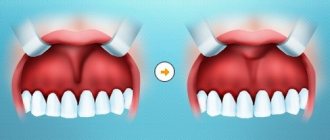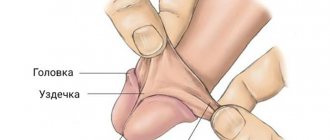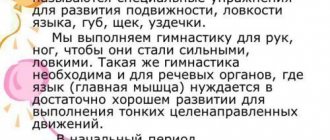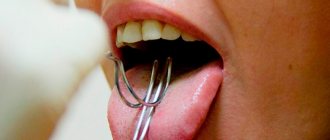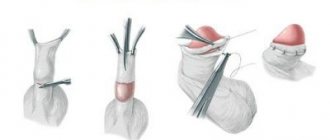Unfortunately, even parents who are not privy to medical subtleties are familiar with the opinion that a short frenulum of the tongue in a child is the cause of speech therapy problems.
Why "Unfortunately"? Because it is ignorance of the material that leads to a clear decision - the bridle needs to be trimmed! Do you remember in the film “Pokrovsky Gate” the characteristic female surgeon with her famous phrase “Cut!.. without waiting for peritonitis”? So the same thing often happens to the poor bridle. However, as experience shows, there is not always only one way out. Not every case of the so-called “short frenulum” requires radical measures.
What is a short frenulum of the tongue?
The frenulum is a thin partition that connects the tongue and the lower oral cavity. Normally, the frenulum is quite elastic, stretches well and is attached to the tongue in its middle part.
An abnormal structure may be the location of the frenulum closer to the edge of the tongue or even at its tip. In addition, a significant decrease in its elasticity, that is, its ability to stretch, is possible.
So in fact, the concept of “short bridle” is not entirely correct. Therefore, there is no clear solution to this issue.
Frenum trimming with laser
Laser frenulum trimming is a simpler, faster procedure that does not cause bleeding. Laser procedures are distinguished by their antibacterial effect, comfortable perception of the procedure by the patient, and the absence of a long recovery period. The laser beam instantly seals the vessels of the frenulum of the tongue, which does not require sutures. Pain relief is usually done using a gel or spray.
Don't be afraid to sign your child up for surgery. By solving the problem with the length of the frenulum, you will give your baby freedom of diction and free him from the feeling of constraint. Make an appointment at the Mira clinic for a consultation by phone.
What is the problem with the incorrect structure of the frenulum of the tongue?
In infants, an abnormal frenulum structure can cause difficulty sucking. In this case, the problem is solved in the maternity hospital by pruning. If the baby is still able to eat normally, doctors try to leave the situation alone, giving, as they say, time to grow. Indeed, in many cases, along with the growth of the jaw, the frenulum gradually stretches and takes on a normal shape.
In older children, a short hyoid frenulum creates some speech therapy difficulties:
- Difficulties arise with the pronunciation of hissing sounds.
- Correct reproduction of sonorants is not possible.
To pronounce the so-called upper lingual sounds, you need to raise the tip of your tongue upward. An insufficiently elastic bridle prevents this from being done.
However, it is very important to understand that it is not “responsible” for all speech problems. So if a child has a delay in speech development, syllables and sounds are “confused” in speech, a limited vocabulary or other problems, a short frenulum has nothing to do with it. The speech therapist will suggest effective methods of correction.
Impact of frenulum pathology
Problems with speaking
But sometimes a child has a congenital pathology - shortened frenulum .
Such a diagnosis means that the frenulum is not attached in the middle of the tongue, but much closer, at the tip. Sometimes it lasts until the very tip, and the tongue even slightly bifurcates from its pressure. A serious pathology is diagnosed after the birth of a child by a neonatologist, and minor deviations in the length of the frenulum can be detected in preschool age, when the child begins to have problems pronouncing certain sounds.
Problems with breastfeeding
In infancy, a shortened frenulum can interfere with breastfeeding, as the baby cannot grasp the nipple comfortably, often loses it, and may even experience pain when sucking. This negatively affects the child’s weight gain and causes a lot of unpleasant moments for the whole family.
How to check if a child has a short frenulum
The presence of difficulties with the frenulum can be easily determined independently:
- Open your mouth slightly and place the tip of your tongue in the area behind your upper teeth. In this position, the place of attachment of the frenulum is clearly visible. If it is not “where it needs to be,” it is difficult to lift the tongue up.
- Pull your tongue forward. A short frenulum does not allow this to be done; in addition, the tip of the tongue visually looks forked
- Open your mouth and try to touch your upper lip with your tongue and lick it. Difficulties with the bridle make this movement difficult to perform.
Please note: sometimes a child cannot cope with these exercises not because there is something wrong with the frenulum. The cause may be weak muscles of the articulatory apparatus. Take a clean handkerchief and try to help your tongue. If resistance is felt when moving, then the problem is still in the hyoid frenulum.
Article:
Practicing speech therapists in their work often encounter mechanical (organic) dyslalia, in which the structure of the organs of the articulatory apparatus is disrupted and, as a result, sound pronunciation suffers.
The content of this article reveals speech therapy work with a large category of dysleptics - children with a shortened hyoid ligament (frenulum). Hypoglossal ligament If the frenulum is shortened, tongue movement is limited. As a result, the pronunciation of sounds that require raising the tongue upward ([w], [zh], [r], etc.) is disrupted.
To trim or not?
Even if the frenulum is shortened (less than 8 mm), it is better to stretch it than to operate. This is supported by the fact that after the operation there will be a scar on the frenulum, which will also reduce its mobility. In addition, the operated child will be afraid to do articulation exercises for the hypoglossal ligament for a long time in order to avoid the previously experienced pain. The short frenulum of the tongue is stretched to the required length using special exercises. If it is very short, it may take quite some time to stretch it (maybe about three months).
Rules for performing exercises according to M.A. Polyakova1. When performing exercises, the mouth should be opened as wide as possible, but at the same time so that the child can reach the alveoli with the tip of the tongue. 2. All movements should be performed slowly, with a smile, close to the limit of what is possible. 3. Keep in mind that doing exercises is physically difficult for a child, the tongue may get tired, the hyoid ligament may hurt - give him a rest. Articulation exercises for stretching the frenulum of the tongue “Painter” Smile, open your mouth. Using the wide tip of your tongue, stroke the palate from the teeth to the throat. The lower jaw should not move. “Horse” Smile, open your mouth. Click the tip of your tongue like a horse clicking. The mouth is open, the tip of the tongue is not extended or pointed. Make sure that it does not tuck inward and that the lower jaw remains motionless. “Mushroom ” This is the cap of the mushroom, and the hyoid ligament is the stalk. The tip of the tongue should not turn up, the lips should be in a smile. If the child is unable to suck his tongue, then he can click his tongue, as in the “Horse” exercise. Clicking trains the desired movement of the tongue. Smile, open your mouth. Suck your wide tongue to the roof of your mouth. “Accordion” Position of the tongue as in the “Mushroom” exercise, lips in a smile. Without lifting your tongue, open and close your mouth. “Drum ” Smile, open your mouth. Repeatedly and clearly pronounce the sound D-DD. When pronouncing this sound, the tongue rests on the upper teeth, do not close the mouth. Very often, when performing this exercise, the child closes his mouth. To prevent this from happening, you can hold a stick about 1 cm wide or the handle of a rectangular children's toothbrush between your teeth (the handle should not be thick, it should be straight, like a ruler). “ Swing ” Smile, open your mouth. On the count of “one-two”, alternately rest your tongue on the upper and lower teeth. The lower jaw is motionless. “Reach your nose” Smile, open your mouth. Raise the wide tip of the tongue towards the nose and lower it towards the upper lip. Make sure that the tongue does not narrow, and that the lips and lower jaw are motionless. “Football ” Close your mouth, press the tip of your tongue with tension into one or the other cheek so that the balls are inflated under the cheek. “Kitten ” Put a little condensed milk (sour cream, jam) on a saucer and invite the child to lick it with his tongue like a kitten. You can also lick the ice cream. “Fungus” with elements of self-massage Suggest performing the “Fungus” exercise. The child rubs the frenulum himself with his thumb and forefinger.
Mechanical assistance when performing articulation exercises
If the tongue sags, the child cannot perform the “Horse”, “Mushroom” exercises, then for proper stretching, the speech therapist takes a probe (“comb”) and lifts the tongue or “swings” it on the “comb”. Tongue frenulum massage
Using the thumb and index finger of your left hand, grasp the tip of your tongue and lift it up. The mouth is open. Using the index finger and thumb of your right hand, use a stretching motion to slide along the frenulum of the tongue from bottom to top.
Stretching the frenulum Reception E.V. Novikova
Having placed a sterile scarf (napkin) on the tongue, place the index and middle fingers under the tongue, frenulum between the fingers, press the thumb on the front of the tongue and perform pulling movements of the tongue outward. The index and middle fingers are motionless.
Exercise “Mole” Reception N.G. Vodovozovaya
Use your index fingers and thumbs to pull your tongue down by the tip. Use your index fingers and thumbs to pull your tongue upward by the tip. With your index finger, forcefully stroke the hyoid frenulum from bottom to top, stretching it. Rules for setting sounds with a short frenulum (M.A. Polyakova) Sounds that require a noticeable rise of the tip of the tongue upward ([p], [w], [g]) are placed after the child’s hyoid ligament is fully stretched. Sounds ([l], [h], [sch], [t'], [d']) can be started when the frenulum has not yet fully stretched, but there is already some upward movement of the tip of the tongue. A short frenulum does not interfere with the normal pronunciation of other sounds of the Russian language.
Who to contact for help
Depending on the complexity of the situation, an orthodontist or speech therapist will help you cope with the problem. In any case, it makes sense to first get a consultation to decide what method of correction the child needs.
The dentist will carefully trim the frenulum, relieving the child of discomfort with one movement of his hand. However, recently doctors still recommend leaving surgical intervention as a last resort. An experienced speech therapist will offer a set of exercises and massage to stretch the frenulum.
Experts say that there are not many situations when the hyoid frenulum is absolutely unable to stretch. In almost all cases, a conservative approach achieves results.
Parents can evaluate the pros and cons of different approaches on their own.
Surgical method:
- A quick, radical solution to the problem.
- The operation is performed using anesthesia.
- The healing process takes some time and is uncomfortable.
- Dietary restrictions due to surgery.
- It is advisable to maintain vocal rest for several days.
- Psychological trauma in the child is possible.
- After the operation, classes with a speech therapist are necessary to correct sound pronunciation.
Frenum stretching method:
- Conservative, does not cause psychological difficulties in the child.
- Effective in most cases.
- Does not require changes to your usual routine.
- It takes some time (several months).
- Requires discipline and regular practice.
In any case, to resolve the issue, you need to consult a speech therapist.
At what age should this be done?
If we talk about a non-surgical method for stretching the hyoid ligament, it is effective up to the age of 5 years with constant and regular training.
The operation as a whole has no restrictions and no special recommendations about at what age it should be done. Each stage of development of a child’s body requires one of several ways to correct this ligament. Thus, newborns undergo a dissection of the frenulum, and already at the age of 2–3 years, when the tissue of the ligament becomes denser, the need for sutures arises. Sometimes it may be necessary to remove some of the ligament tissue. Laser surgery has no age restrictions.
To avoid the formation of malocclusion and displacement of the dentition, it is advisable to correct the frenulum before the molars appear.
Price and cost of surgery for short frenulum of the penis in children
Short frenulum of the penis
| Service | Price |
| Frenum plastic surgery | 20,000 rub. |
| Plastic surgery of the frenulum with plastic surgery of the foreskin | 45,000 rub. |
The cost of the operation includes (no additional payment for services is necessary!):
- inpatient accommodation 1 day double room with all amenities
- preoperative tests
- disposable suture material Vicryl, PDS
- application of intradermal cosmetic suture
- disposable surgical consumables
- surgical instruments Ceatec GmbH Germany
- microsurgical instruments and equipment
- constant telephone communication with the attending physician
- examination any day in the clinic within 14 days after surgery
The cost of the operation does not include: anesthesia, additional diagnostics and treatment of concomitant diseases and their complications.
Anesthesiological support: anesthesiological apparatus Drager Fabius Plus (Germany), combined general anesthesia (inhalation anesthesia, caudal/local anesthesia).
** This is not a public offer agreement. Check the cost of services on the day of your request.
Our advantages
Experienced surgeons
Individual approach
Without pain and fear
Comfortable conditions
